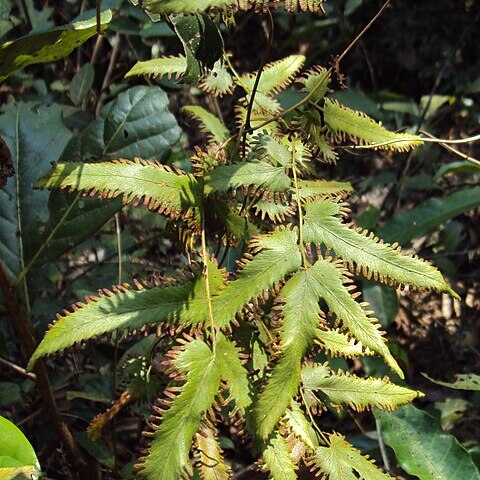Rhizome shortly creeping and densely covered with roots, stipes very close together; apex of rhizome covered with dark brown to nearly black hairs. Juvenile fronds once or twice dichotomous, each branch bearing a single pinna deeply palmately 3-7-lobed, lobes almost equal, base of whole pinna cordate, margins serrate and sometimes crenately lobed. Rachis of scandent fronds narrowly winged, flattened and puberulent on adaxial surface between wings; primary rachis branches up to 3 mm (lower ones longest), dormant apex covered with pale brown hairs; secondary rachis branches pinnate to somewhat bipinnate, narrowly ovate to deltoid in outline, commonly ca. 15 × 8 cm; sterile pinnae of lower branches palmate, often 5-lobed, base strongly cordate; higher secondary branches bearing 3-5 (sometimes up to 7) pinnae on each side and an apical one, apical and lower pinnae asymmetrical or ± lobed at base, lowest of branches with 2 or 3(-6) separate quaternary pinnae at base; sterile pinnae 3-10 cm × 8-15 mm above lobed base, margin serrate, apex subacute, lower pinnae stalked, upper pinnae sessile, lamina rather thin; costae usually with scattered long hairs, less often with dense short hairs, veins often with scattered short hairs on abaxial surface, lamina sometimes similarly hairy; fertile pinnae smaller than sterile pinnae, sorophores 3-5 mm (rarely up to 10 mm), at apices of small triangular lobes; indusia glabrous or with a few hairs like those of abaxial surface of lamina; spores finely evenly verrucose.
Rhizome short creeping. Juvenile fronds once-forked; pinnae palmate, 5–7-lobed; margins crenulate to serrulate. Rachis slightly pubescent, subterete, flattened on 1 side, narrowly winged or tetragonous; primary rachis branches 2–16 mm long; secondary pinnae narrowly ovate to oblong or rarely palmate, 7–20 cm long, 4.5–12 cm wide, 1–2-pinnate; pinnule stalks reducing in length towards pinna apex; ultimate pinnules 1.5–10 cm long, 5–16 mm wide; sterile ones sometimes fused basally and palmately-lobed, membranous, glabrous or sparsely pubescent; base truncate; margins serrulate; veins free; sterile pinnules similar in length or longer than sporogenous ones. Sporogenous lobes 1.5–8 mm long.
A large fern. It has a short creeping rhizome. It is a climber. It grows 2 m tall. There are 2 kinds of leaves, Sterile leaves are narrow to sword shaped. The fertile leaflets are smaller and have frills around the edge.

